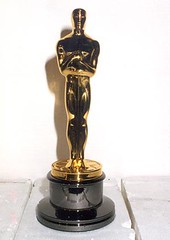 Aunque los Oscars se entregarán el próximo día 24 de Febrero, hay una serie de Oscars a los logros Científicos y Técnicos que mejoran la industria del cine que fueron anunciados hace ya algún tiempo.
Aunque los Oscars se entregarán el próximo día 24 de Febrero, hay una serie de Oscars a los logros Científicos y Técnicos que mejoran la industria del cine que fueron anunciados hace ya algún tiempo.
Entre estos ganadores hay unos españoles, se trata de Víctor González, Ignacio Vargas y Ángel Tena, que se llevarán el premio por la creación del software RealFlow, que se utiliza en la recreación de fluidos y ha sido utilizado en muchas películas, además de tener aplicaciones técnicas en otros campos. La empresa madrileña que ha desarrollado el programa se llama Next Limit Technologies.
Esta gente trabaja para estudios como Disney o Pixar y el programa ha sido utilizado en películas como El Señor de los Anillos, La Tormenta Perfecta, Ice Age, Matrix, etc.
Solamente un español había sido premiado en estos apartados técnicos, se trata de Juan de la Cierva, que fue el primero en conseguir un premio de la academia en 1969.
El premio no lo recibirán en la gala donde se entregan el resto, sino en una cena aparte el próximo 9 de Febrero.
De lo que no estoy seguro es de que se vayan a llevar una estatuilla a casa, ya que según la nota de prensa de la academia americana el premio consiste en un Certificado de la Academia… los premiados dicen que sí, así que ya se encargarán de enseñarlo.
Esta es la lista total de premiados en estos apartados (en Versión Original):
Technical Achievement Awards (Academy Certificate)
To Christien Tinsley for the creation of the transfer techniques for creating and applying 2D and 3D makeup known as “Tinsley Transfers.”
These techniques allow quick and precisely repeatable application of 2D makeup such as tattoos, bruises and birthmarks, as well as 3D prosthetic appliances ranging in size from small wounds to entire torsos. They utilize self-adhesive material that features an unprecedented combination of tissue-thin edges, resilience, flexibility and water resistance, while requiring no dangerous solvents.
To Jörg Pöhler and Rüdiger Kleinke of OTTEC Technology GmbH for the design and development of the battery-operated series of fog machines known as “Tiny Foggers.”
The operating characteristics of this compact, well-engineered and remote-controllable package make possible a range of safe special effects that would be totally impractical with larger, more conventional fog units.
To Sebastian Cramer, for the invention and general design and Andreas Dasser, head of development at P&S Technik GmbH, for the mechanical design of the Skater Dolly and its family of products.
This small, portable, camera-only dolly allows low lens positions, movement in restricted places and tight offset circular maneuvers with rapid set-up.
To Victor Gonzalez, Ignacio Vargas and Angel Tena for the creation of the RealFlow software application.
RealFlow was the first widely adopted, commercially available, easy-to-use system for the simulation of realistic liquids in motion picture visual effects.
To Jonathan Cohen, Dr. Jerry Tessendorf, Dr. Jeroen Molemaker and Michael Kowalski for the development of the system of fluid dynamics tools at Rhythm & Hues.
This system allows artists to create realistic animation of liquids and gases, using novel simulation techniques for accuracy and speed, as well as a unique scripting language for working with volumetric data.
To Duncan Brinsmead, Jos Stam, Julia Pakalns and Martin Werner for the design and implementation of the Maya Fluid Effects system.
This system is used to create simulations of gaseous phenomena integrated into the widely available Maya tool suite, using an unconditionally stable semi-Lagrangian solver.
To Stephan Trojansky, Thomas Ganshorn and Oliver Pilarski for the development of the Flowline fluid effects system.
Flowline is a flexible system that incorporates highly parallel computation, allowing rapid iteration and resulting in detailed, realistic fluid effects.
Scientific and Engineering Awards (Academy Plaque)
To Dr. Doug Roble, Nafees Bin Zafar and Ryo Sakaguchi for the development of the fluid simulation system at Digital Domain.
This influential and flexible production-proven system incorporates innovative algorithms and refined adaptations of published methods to achieve large-scale water effects.
To Nick Rasmussen, Ron Fedkiw and Frank Losasso Petterson for the development of the Industrial Light & Magic (ILM) fluid simulation system.
This production-proven simulation system achieves large-scale water effects within ILM’s Zeno framework. It includes integrating particle level sets, parallel computation, and tools that enable the artistic direction of the results.
Academy Award of Merit (Oscar® Statuette)
To the Eastman Kodak Company for the development of photographic emulsion technologies incorporated into the Kodak Vision2 family of color negative films.
These technologies are breakthroughs in film speed, grain and sharpness that have made a significant impact on the motion picture industry. The Vision 2 family allows wider use of high-speed color negative film, lower light levels on set and faster set-ups. Most importantly, Vision2 improves the overall picture quality in theatrical presentation.
The Scientific and Technical Special Awards to be presented at the February 9 ceremony are:
Award of Commendation (Special Plaque)
To Jonathan Erland in recognition of his leadership and efforts toward identifying and solving the problem of High-Speed Emulsion Stress Syndrome in motion picture film stock.
By coordinating and conducting tests for and with the industry and by sharing results openly, Mr. Erland clearly demonstrated the value and effectiveness of independent research and industry-wide cooperation.
John A. Bonner Medal of Commendation (Medallion)
To David S. Inglish, for his outstanding service and dedication in upholding the high standards of the Academy of Motion Picture Arts and Sciences.
Gordon E. Sawyer Award (Oscar Statuette)
To David A. Grafton, whose technological contributions have brought credit to the industry.
Fuente | Oscars.org